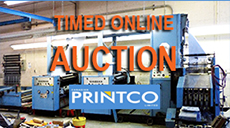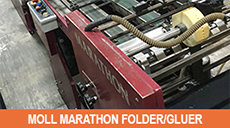
|
|
| Home › Articles › Here |
  
|

|
||||||||||||||
| By: Nick Howard | Date: October 2011 | Contact the Author |
|||||||||||||||
| In the fall of 1974, in Los Angeles, the Harris Intertype Corporation presented an extensive report concerning the future of offset printing. The report was presented to the National Association of Printers and Lithographers (NAPL). The North American economy, at the time, was deep in the doldrums as reflected in high fuel costs, shortages of paper and weak consumer confidence. As I revisited this 37-year-old report, I found an incredible amount of similarities, in terms of challenges and opportunities, faced by today’s printing industry. Similarities abound propped up by the poor, lingering economic climates of both eras. There also appears to be several technological antidotes shared between now and then. Shifting from sheet to web offset Harris spent the equivalent of two years, in terms of man-hours, to produce the report, collecting mass amounts of data and in-putting computers of the day. The company based a large portion of the report around its own hypothetical printing plant equipped with various sheetfed presses, ranging from single-colour, perfectors to multi-colour. 18 different press models in all. The results were encouraging: The report found that 92-percent of all offset printing would continue to be printed on sheet-fed presses and 71-percent of dollars available in the next five years would directly come from sheetfed work. The Harris study also indicated how web-offset production was growing at a much faster clip than sheetfed, hitting annual growth rates of between 25 and 30-percent from a smaller install base. Harris was entrenched in both the sheetfed and web-offset markets, and in 1974 was widely recognized as the dominant supplier and largest printing machinery builder anywhere. In the late 1950s, Harris started making acquisitions outside of the traditional printing-machine sector, such as with the purchase of Radiation Inc. of Melbourne Florida. Electronic communications was seen by Harris as the gateway to further growth and the future. In retrospect, Harris was the first printing machinery builder to step into diversification and re-invention. During the early 1970s, very few 38-inch multi-colour sheetfeds existed with more than five units. In fact, less than eleven 6-colour, 38-inch presses (mostly of Harris vintage) were operating in the market. Of note a larger population of machines in the 60- and 76-inch variety were installed and dwarfed the 38” format in total numbers. This was an environment controlled essentially by both Miehle and Harris, while several smaller manufacturers chased what was left. During this period, a printer was thought of as either a “Miehle man” or a “Harris man.” By January 1975, Harris, based largely on its watershed study, shocked the entire print industry when it announced it would discontinue manufacturing sheetfed presses, concentrating on Web offset and bindery. As illustrated by a company spokesman, it was no secret that Harris was unprofitable with sheet-fed: “There’s a world of difference between making money operating sheetfed presses and making money manufacturing them.” Back in the 1970s, many countries outside of North America, particularly Germany and Japan, had much lower manufacturing costs than those experienced in the United States. The favorable exchange rates of the time pushed those countries to export at much lower costs than Harris could make the equipment. By 1972, Harris Corp. was earning almost half their revenues in electronics and this segment was growing fast. Manufacturing sheetfed machines in the climate of the early 1970s, with new stringent rules around effluent containment and organized labour, created a North American mass exodus from industrial-production sectors, well beyond graphic-arts equipment. The continuation of sheetfed just did not cut it with Harris, even though the “report” clearly stated sheetfed printing was growing. This press-manufacturing environment allowed other makers, particularly Heidelberg, to cash in on the sheetfed vacuum and jettisoned Heidelberg to unprecedented heights. Harris, meanwhile, pushed its web division to become the predominant supplier for everything from 8-page M-110s to the N series insert press. First Heidelberg, then Goss acquired ownership of the Harris Web division, which controlled the formidable M-Class machines (M-600) and the innovative “Sunday” gap-less technology. (Original Harris engineering continues to make a significant impact on today’s web-offset market.) With successive purchases of PRD Electronics and RF communications, in its focus at diversification, Harris had done the unimaginable and re-built itself into the highly specialized company we know today. It’s incredible to consider how this decision was made while the company was on top of the press-making world. Harris began in 1895 by two brothers Alfred and Charles. Who developed their own letterpress envelope printing machine and went on to become the forefathers of modern lithography. |
|||||||||||||||
|
|||||||||||||||





